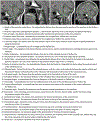Influence of Pain on Cognitive Dysfunction and Emotion Dysregulation in Chiari Malformation Type I
- PMID: 35902471
- PMCID: PMC12564539
- DOI: 10.1007/978-3-030-99550-8_11
Influence of Pain on Cognitive Dysfunction and Emotion Dysregulation in Chiari Malformation Type I
Abstract
It has been well demonstrated that the cerebellum is associated with cognitive and affective processing as well as the traditionally conceptualized motor function. In the present chapter, we explore the behavioral and neurobiological implications of a common congenital cerebellar condition, Chiari malformation Type I, on cognitive and affective processing. We also emphasize the associations between Chiari-related chronic pain, cognitive dysfunction, and emotion dysregulation. Based on our review of the literature, we argue that chronic pain can account for a substantial amount of the cognitive dysfunction and emotion dysregulation in Chiari malformation Type I. Yet, there also exists aspects of Chiari-related cognitive dysfunction and emotion dysregulation that appear to be at least partially independent of chronic pain and more directly associated with abnormalities in cerebrospinal fluid flow dynamics and cerebro-cerebellar communication pathways.
Keywords: Attention; Chiari malformation; Chronic pain; Cognitive control; Emotion regulation.
© 2022. The Author(s), under exclusive license to Springer Nature Switzerland AG.
Figures









References
Publication types
MeSH terms
Grants and funding
LinkOut - more resources
Full Text Sources
Medical

